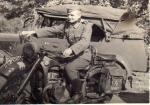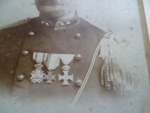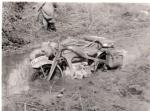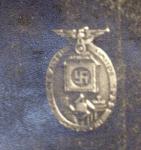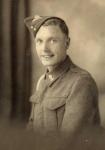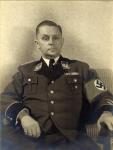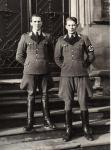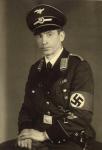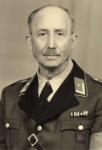-
Posts
2,143 -
Joined
-
Last visited
-
Days Won
10
Content Type
Profiles
Forums
Blogs
Gallery
Events
Store
Everything posted by Odulf
-
Not a Kriegsmarine tally, but Bundesmarine, reading Abschnittskommando .... There were 2 Abschnittkommandos, one for the Nordsee (Northsea) and the other for the Ostsee Baltic). Ten years after the war ended, and Germany was split in two nations (the Deutsche Bundesrepublik - "West Deutschland", and the Deutsche Demokratische Republik - "Ost Deutschland"), the Bundesrepublik was allowed to establish a military defence force, the Bundeswehr. The Bundeswehr consisted of three Arms of Service: Bundesheer (Army), Bundesmarine (Navy), Bundesluftwaffe (Air Force). Between 1955 and 1960 the Bundesmarine had cap tallies with Gothic script which was changed in Latin script in 1960 and still used today. Please note also: http://gmic.co.uk/index.php/files/32-bundesmarine-cap-tallies-1955-1990/
-
And another new face, Otto Lancelle (1885-1941) with Pour le Mérite, Leiter der Reichsschule und Inspekteur der Lehrabteilungen, who lost his job in 1934 to Hermann Kretschmann (see above) after an alleged mutiny against Decker and Hierl. He was a reserve officer in the Army and he was re-activated in October 1935. Promoted Major-General and commanding the 121. Infanterie-Division, he was shot by a sniper in Latvia on 3-7-1941. Posthumous he received the Knights Cross of the Iron Cross.
-

Photo - Palestine 1937-39
Odulf replied to SMLE's topic in Great Britain: Militaria: Badges, Uniforms & Equipment
The slouch hat was not exclusively worn by Australian troops. Since the Boer War British units overseas (Africa, Middle East, Far East) also were issued with this type of head dress. -

H.M.S. HOOD & HITLER"S NAVY
Odulf replied to Mervyn Mitton's topic in Great Britain: Research, Documentation & History
-
If it is of any help, I can tell you that is is not Dutch, Belgian, French....
-

The Great and Unavoidable War
Odulf commented on Brian Wolfe's blog entry in News From the Home Office.
Gents, in an earlier topic, ignited by Gunner, I expressed what event lead up to the conflict. Sometimes people ask me: "Why would any one write another book about any war, because it has all been investigated, said and told... As a writer of historical articles with a military relation I read the products of others, and it is interesting to note that the perspective on war in general is ever changing (like looking through a kaleidoscope). That is also why hostorians and writers will ever have reasons to write articles and books; in particular books about the cause, the reasoning, the effects, the "what if...", and other themes. Also, about uniforms and equipment there has been a host of books... I also grew up in the 60s, and books about the nitty gritty details of uniforms were like hen's teeth, but today there are many good and even better books... All this raises the question with me: "What will future generations write and read" and "How much more information can be added to what we already have"? Sometimes it is new wine in old sacks (not to be taken personaly), just a repeat or summary of earlier texts, but also there are new scopes of looking at a war from a different angle. By now, I think, we have venued all angles, but the subject is like the nucleus of a sphere or atom, and there are countless points of view. Naturaly, modern viewers relate the phenomenon from a modern perspective, and that is all right, but we cannot untie the war from it's own context. The matter raised earlier (what did simple people, without a scala of opinions - like we do - feel and do?) is of great importance.... They were not ignorent, but had limited sources of information. Also, The modern Europe (as we know it) was rather young, only a century had passed since Napoleon. Only little more than half a century (for some nations) since some kind of democracy developed. Communications were slow, and from a modern perspective it is all very hard to understand. The world, as most people knew it, was exploding (in may ways), the perspectives blew up to make one feel like taking part in "Alice in Wonderland", and also the rather young Nations drummed up for protection and continuation of the national dreams. It was (in modern words) surrealistic and even artists with a keen eye for absurdism lost track. Even with our little skull contents it is hard to understand the riducule chess match which was played on many boards, however, we know the result (which is not refreshing, and far from an American feel-good western). After a life long study, I have come to the conclusion that there are no good guys and bad guys, there are only loosers. For every winner lost and the world did not end up to be a better place, except for those who financed the whole bloody business. -

Royal Artillery badges
Odulf replied to IrishGunner's topic in Great Britain: Militaria: Badges, Uniforms & Equipment
Two gunners of the (British) Royal Artillery The first portrait is dated 28 June 1940. The guy is wearing the 1937 pattern battle dress blouse, with collar badges (!), a metal shoulder title "RA", and a white lanyard from the right shoulder. The arms-of-service stripe is absent. The other photo was made by a photographer in Hythe (Kent), showing the woolen service dress (with 4 pockets and brass buttons) with collar badges, brass "RA" titles and the white lanyard. -

Royal Artillery badges
Odulf replied to IrishGunner's topic in Great Britain: Militaria: Badges, Uniforms & Equipment
Two portraits of gunners of the Royal Canadian Artillery, in the Netherlands in 1945. The first is named: Gnr. J. Harvey A65778 83 Field Btr. 23 SP Regt. R.C.A. Canadian Army Overseas 25 September 1945 The second: Ben Webser 2ns Can.AGRA (Nijmegen) The 23rd Field Regt. RCA were self propelled howitzers and a supporting unit of the 4th Canadian Armd. Division. Because of their armoured vehicles and serving with an armoured unit the berets were black, as for all British and Canadian armoured divisions. The 2nd Canadian Army Group Artillery operated in The Netherlands, supporting the 2nd Canadian Army with heavy artillery. As I was told by an Artillery veteran, personnel of heavy artillery units (up from 25 pdr. guns) wore the gun on their beret. Light artillery, ant-aircraft-artillery, surveyer units, etc. wore the grenade badge on their beret and field cap. -

The Great and Unavoidable War
Odulf commented on Brian Wolfe's blog entry in News From the Home Office.
"The only thing we learn from history is that we learn nothing from history" G.W.F. Hegel -

Unidentified Uniform ID Help
Odulf replied to mikehm's topic in Great Britain: Militaria: Badges, Uniforms & Equipment
Hi Mike, I have this CdV portrait of an officer of the 10th Foot, with a similar patrol jacket and the miniature with clasp for Lucknow, dating around 1860. -
Hi Hugh, My memory failed me, but I have found some notes in my administration. The group consisted of DSM (LG 17.5.1918 p.5860), Africa GSM w. "Somaliland 1908-10" (Hyacinth), Naval GSM w. "PG 1909-14" (Hyacinth), 1914-15 St, LS&GC, Russian Silver Medal of St.George (unnamed but numbered), all British medals were named to AB James Boyd Hendry Anderson (ON 192430 Ch.). The medals were sewn on a piece of uniform cloth, for wear, and I had them re-ribboned; his BWM and Vict. were not originally included but added loose. I kept the old ribbons...




